
All Solutions
Page 446: Getting Started
$$
dfrac{1}{5^2}=dfrac{1}{5cdot 5}=dfrac{1}{25}
$$
$a^2 = acdot a$
$$
a^3=acdot acdot a
$$
$$
11^0=1
$$
$$
a^0 =1
$$
$$
sqrt{36}=sqrt{6^2}=6
$$
$sqrt{a^2}=(a^2)^{1/2}=a$
$$
sqrt[n]{a^m}=(a^m)^{1/n}
$$
$$
sqrt[3]{125}=125^{1/3}=(5^3)^{1/3}=5
$$
$$
=dfrac{9}{4}
$$
left(sqrt[n]{dfrac{a}{b}}right)^k=left(dfrac{a}{b}right)^{k/n}=dfrac{a^{k/n}}{b^{k/n}}
$$
b.) 1
c.) 6
d.) 5
e.) -11
f.) $frac{9}{4}$
$a^2 = acdot a$
$$
a^3=acdot acdot a
$$
$$
a-(-b)=a+b
$$
(a^b)^{1/c}=a^{b/c}
$$
$$
=4^{1/2}=(2^2)^{1/2}=2
$$
b.) 4
c.) 1000
d.) 2401
e.) 4
f.) 2
(a) $(2m)^{3}$
To simplify this expression we have to use the exponent property which state that:
$$
color{#4257b2}boxed{ (ab)^{c}=a^{c} cdot b^{c} }
$$
Now we can simplify this expression as follows:
$$
color{#4257b2}(2m)^{3}= 2^{3} cdot m^{3}= 8m^{3}
$$
(b) $left(a^{4} b^{5}right)^{-2}$
To simplify this expression we have to use the exponent properties which state that:
$$
color{#4257b2}boxed{ (ab)^{c}=a^{c} cdot b^{c} text{and} a^{-b}=dfrac{1}{a^{b}} }
$$
Now we can simplify this expression as follows:
$$
color{#4257b2} left(a^{4} b^{5}right)^{-2} = dfrac{1}{left(a^{4} b^{5}right)^{2}}= dfrac{1}{left(a^{4}right)^{2} left(b^{5}right)^{2}}= dfrac{1}{a^{8} b^{10}}
$$
To simplify this expression we have to use the exponent property which state that:
$$
color{#4257b2}boxed{ left(a^{b}right)^{c}=(a)^{bc} }
$$
Now we can simplify this expression as follows:
$$
color{#4257b2} left(16 x^{6}right)^{tfrac{1}{2}}= left(4^{2} x^{3 cdot 2}right)^{tfrac{1}{2}} = left(4 x^{3}right)^{2 cdot tfrac{1}{2}} = 4x^{3}
$$
(d) $dfrac{x^{5} y^{2}}{x^{2} y}$
To simplify this expression we have to use the exponent properties which state that:
$$
color{#4257b2}boxed{ dfrac{a^{b}}{a^{c}}=a^{b-c} }
$$
Now we can simplify this expression as follows:
$$
color{#4257b2} dfrac{x^{5} y^{2}}{x^{2} y} = left(x^{5-2}right) left(y^{2-1}right)= x^{3} y
$$
To simplify this expression we have to use the exponent property which state that:
$$
color{#4257b2}boxed{ left(dfrac{a}{b}right)^{c}=dfrac{a^{c}}{b^{c}} }
$$
Now we can simplify this expression as follows:
$$
color{#4257b2} left(-d^{4}right) left(dfrac{c}{d}right)^{2} = -d^{4} cdot dfrac{c^{2}}{d^{2}} = -dfrac{d^{4} cdot c^{2}}{d^{2}}= -dfrac{cancel{d^{2}} cdot d^{2} cdot c^{2}}{cancel{d^{2}}}=-d^{2} c^{2}
$$
(f) $left(left(x^{3}right)^{-tfrac{1}{3}}right)^{-1}$
To simplify this expression we have to use the exponent properties which state that:
$$
color{#4257b2}boxed{ left(a^{b}right)^{c}=a^{bc} text{and} a^{-1}=dfrac{1}{a} }
$$
Now we can simplify this expression as follows:
$$
color{#4257b2} left(left(x^{3}right)^{-tfrac{1}{3}}right)^{-1} = left(left(xright)^{3 cdot -tfrac{1}{3}}right)^{-1}=left(left(xright)^{ -1}right)^{-1}= left(xright)^{ -1 cdot -1} = x
$$
text{color{#c34632} a) $ 8m^{3}$ b) $ dfrac{1}{a^{8} b^{10}}$ c) $4x^{3}$ \ \
d) $x^{3} y$ e) $-d^{2} c^{2}$ f) $x$}
$$
$$
color{#4257b2}text{(a)} y=2^x
$$
From the graph we can state that:
Domain $=(-infty, infty)$ Range$=(0, infty)$
$y$ intercept $y=1$
Equation of the horizontal asymptote is $x$ axis $y=0$
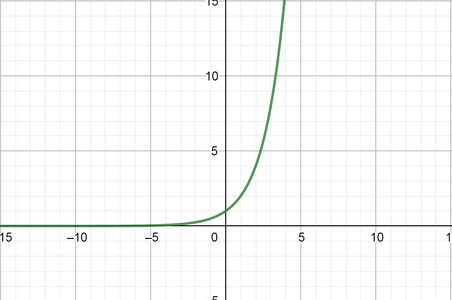
color{#4257b2}text{(b)} y=left(dfrac{1}{2}right)^x
$$
From the graph we can state that:
Domain $=(-infty, infty)$ Range$=(0, infty)$
$y$ intercept $y=1$
Equation of the horizontal asymptote is $x$ axis $y=0$
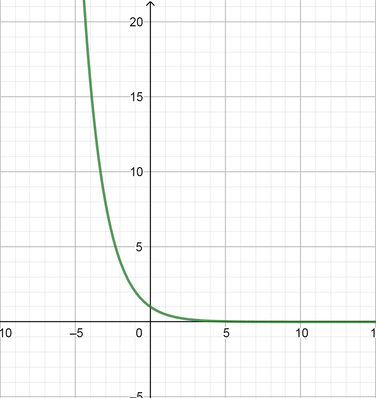
color{#4257b2}text{(c)} y=3^2x-2
$$
From the graph we can state that:
Domain $=(-infty, infty)$ Range$=(-2, infty)$
$y$ intercept $y=-2$
Equation of the horizontal asymptote is $y=-2$
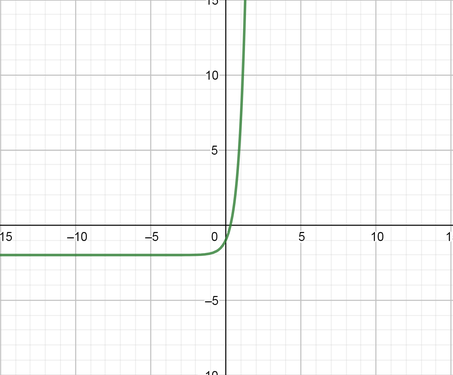
\ \
$y$ intercept $y=1$ Asymptote equation is $x$ axis $y=0$
\ \
(b) Domain $=(-infty, infty)$ Range$=(0, infty)$
\ \
$y$ intercept $y=1$ Asymptote equation is $x$ axis $y=0$
\ \
(c) Domain $=(-infty, infty)$ Range$=(-2, infty)$
\ \
$y$ intercept $y=-2$ Asymptote equation is $y=-2$
\ \}$}$
$$
color{#4257b2}text{(a)} f(x)=3x-6
$$
Substitute the value of $x=y$ as follows:
$$
y=3x-6 x=3y-6
$$
Isolate the $y$ variable on the keft side as follows:
$$
3y=x+6 y=dfrac{x+6}{3}
$$
Substitute the value of $x=y$ as follows:
$$
x=dfrac{y+6}{3} f^{-1}(x)=dfrac{x+6}{3}
$$
$$
color{#4257b2}text{(b)} f(x)=x^2-5
$$
Substitute the value of $x=y$ as follows:
$$
y=x^2-5 x=y^2-5
$$
Isolate the $y$ variable on the keft side as follows:
$$
y^2=x+5
$$
Use square root property as follows:
$$
sqrt{y^2}=sqrt{x+5} y=sqrt{x+5}
$$
Substitute the value of $x=y$ as follows:
$$
x=sqrt{y+5} f^{-1}(x)=sqrt{x+5}
$$
color{#4257b2}text{(c)} f(x)=6x^3
$$
Substitute the value of $x=y$ as follows:
$$
y=6x^3 x=6y^3
$$
Isolate the $y$ variable on the keft side as follows:
$$
y^3=dfrac{x}{6}
$$
Use cubic root property as follows:
$$
sqrt[3]{y^3}=sqrt[3]{dfrac{x}{6}} y=sqrt[3]{dfrac{x}{6}}
$$
Substitute the value of $x=y$ as follows:
$$
x=sqrt[3]{dfrac{y}{6}} f^{-1}(x)=sqrt[3]{dfrac{x}{6}}
$$
color{#4257b2}text{(d)} f(x)=(x-4)^2+3
$$
Substitute the value of $x=y$ as follows:
$$
y=(x-4)^2+3 x=(y-4)^2+3
$$
Isolate the $y$ variable on the left side as follows:
$$
(y-4)^2=x+3
$$
Use square root property as follows:
$$
sqrt{(y-4)^2}=sqrt{x+3} y-4=sqrt{x+3}
$$
$$
y=sqrt{x+3}+4
$$
Substitute the value of $x=y$ as follows:
$$
x=sqrt{y+3}+4 f^{-1}(x)=sqrt{x+3}+4
$$
text{color{#c34632}(a) $f^{-1}(x)=dfrac{x+6}{3}$ (b) $f^{-1}(x)=sqrt{x+5}$
\ \
(c) $f^{-1}(x)=sqrt[3]{dfrac{x}{6}}$ (d) $f^{-1}(x)=y=sqrt{x+3}+4$}
$$
$$
color{#4257b2}text{(a)} 12 text{hours}
$$
We make a general expression represent the bacterial where any time as follows.
$$
a_{4n}=100 (2)^n text{Where:}
$$
$4n=$ total time needed $n=$ number divided by $4$
For $text{color{#4257b2} $12$ hours}$
$$
4n=12 n=dfrac{12}{4} n=3
$$
$$
a_{12}=100(2)^3 a_{12}=100cdot8
$$
$$
a_{12}=800 text{Bacterial}
$$
$$
color{#4257b2}text{(b)} 1 text{day}
$$
$$
a_{4n}=100 (2)^n text{Where:}
$$
$4n=$ total time needed $n=$ number divided by $4$
$$
1text{ day}=24 text{hours}
$$
$$
4n=24 n=dfrac{24}{4} n=6
$$
$$
a_{24}=100(2)^6 a_{12}=100cdot64
$$
$$
a_{24}=6400 text{Bacterial}
$$
color{#4257b2}text{(c)} 3.5 text{days}
$$
$$
a_{4n}=100 (2)^n text{Where:}
$$
$4n=$ total time needed $n=$ number divided by $4$
$$
3.5cdot24=84text{ hours}
$$
$$
4n=84 n=dfrac{84}{4} n=21
$$
$$
a_{84}=100(2)^{21} a_{12}=100cdot2097152
$$
$$
a_{84}=209715200 text{Bacterial}
$$
$$
color{#4257b2}text{(d)} 1 text{week}
$$
$$
a_{4n}=100 (2)^n text{Where:}
$$
$4n=$ total time needed $n=$ number divided by $4$
$$
1text{ week}=7cdot24=168 text{hours}
$$
$$
4n=168 n=dfrac{168}{4} n=42
$$
$$
a_{168}=100(2)^{42} a_{12}=100cdot4398046511104
$$
$$
a_{168}=439804651110400 text{Bacterial}
$$
$color{#c34632}(c) a_{84}=209715200 text{Bacterial}$ $color{#c34632}(d) a_{168}=439804651110400 text{Bacterial}$
We make a general expression represent the decline rate after years as follows:
$$
a_n=dfrac{15000}{1.2^n} text{Where} n=text{number of year}
$$
The number of years from $2005$ to $2020$ is $15$ years.
$$
a_{15}=dfrac{15000}{1.2^{15}} a_{15}=dfrac{15000}{15.4070215}
$$
$$
a_{15}=973.582
$$
The population in $2020$ will be $973.582$
text{color{#c34632}The population in $2020$ will be $973.582$}
$$
$$
y=3(2^x) y=3left(dfrac{1}{2}right)^x
$$
Fore the first equation:
Domain $=(-infty, infty)$ Range$=(0, infty)$
Equation horizontal asymptote is $x$ axis $y=0$
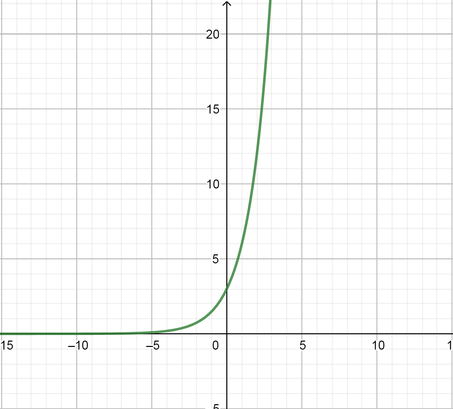
Domain $=(-infty, infty)$ Range$=(0, infty)$
Equation horizontal asymptote is $x$ axis $y=0$
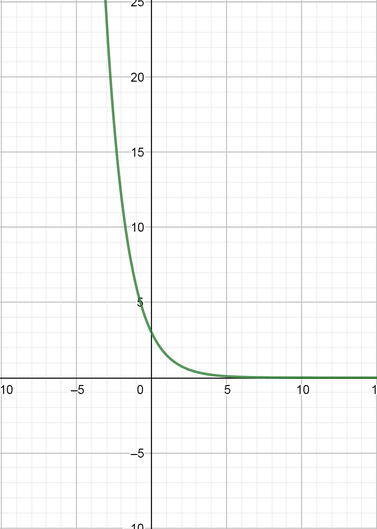
text{color{#c34632}Domain $=(-infty, infty)$ Range$=(0, infty)$
\ \
Equation horizontal asymptote is $x$ axis $y=0$}
$$

